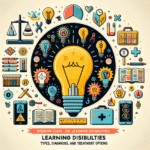
Is It More Than Just Math Anxiety? Identifying Dyscalculia in Children: The Ultimate Guide
Introduction
Imagine a young child sitting at a desk, pencil in hand, staring blankly at a math worksheet. For some, math may spark joy or intellectual curiosity, but for others, it can evoke fear and frustration. As teachers and parents, we often label this frustration as "math anxiety," but what if there is more lurking beneath the surface? Is it more than just math anxiety? Identifying dyscalculia in children is crucial, as unnoticed learning disabilities can significantly affect a child’s educational trajectory. In this article, we will delve deep into dyscalculia—what it is, how to identify it, and the impact it can have on a child’s overall well-being.
Understanding Dyscalculia: What Is It?
Dyscalculia is a specific learning disability that affects an individual’s ability to understand numbers and perform mathematical calculations. While many children face challenges with math, dyscalculia is characterized by a persistent difficulty in learning numerical concepts, often leading to underperformance in math-related tasks.
Signs and Symptoms
Identifying dyscalculia early is essential for providing the appropriate support. Here are some common signs and symptoms to watch for:
- Difficulty understanding number concepts and relationships
- Trouble memorizing arithmetic facts or formulas
- Frequent errors in math calculation or reasoning
- Difficulty telling time or understanding the concept of time
- Difficulty understanding measurement and spatial concepts
Is It More Than Just Math Anxiety? The Overlap and Distinction
Is it more than just math anxiety? Identifying dyscalculia in children begins with recognizing the distinct features of each condition. Math anxiety typically arises from a fear of failure or negative experiences associated with math. However, if a child continues to struggle despite intervention or demonstrating anxiety about math tasks with no apparent remedial impact, it may indicate dyscalculia.
Table 1: Key Differences Between Dyscalculia and Math Anxiety
| Feature | Dyscalculia | Math Anxiety |
|---|---|---|
| Nature of Difficulty | Consistent struggle with math concepts | Situational fear of math tasks |
| Impact on Overall Learning | Affects various aspects of math learning | Primarily affects performance in stressful situations |
| Age of Onset | Often evident early in elementary school | Can develop at any stage of learning |
| Response to Intervention | Requires specialized strategies and tools | Can improve with practice and support |
Case Study 1: Emma’s Journey with Dyscalculia
Emma, a nine-year-old girl, struggled even with basic arithmetic. Despite her teachers’ efforts in providing support to alleviate what they presumed was anxiety, she continued to face dismal math results. Emma’s parents recognized that this behavior persisted even when they offered a stress-free environment—indicating it wasn’t merely math anxiety. After a comprehensive assessment, Eden was diagnosed with dyscalculia, allowing her to access tailored resources and strategies that have significantly improved her attitude toward math.
Analysis: Emma’s story illustrates the importance of distinguishing between zeroing in on anxiety versus the possibility of a deeper issue like dyscalculia.
The Brain and Dyscalculia: A Scientific Overview
Recent research has shown that dyscalculia may stem from neurological differences in the brain’s functioning. Areas such as the intraparietal sulcus, associated with numerical processing, function differently in individuals with dyscalculia. Understanding these neurological factors can inform effective strategies for intervention.
Identifying Dyscalculia: The Role of Assessment
A comprehensive assessment is vital for identifying dyscalculia. Parents and educators need to be proactive in utilizing specialized assessment tools, including:
- Standardized assessments focusing on numerical reasoning
- Observational checklists
- Consultation with educational psychologists
Case Study 2: Jake’s Diagnostic Path
Jake, a bright student with strong verbal communication skills, faced significant challenges in math. His report cards reflected consistent struggles, yet he seemed focused and engaged during group discussions. After a thorough neuropsychological evaluation, Jake was diagnosed with dyscalculia. With targeted interventions—visual aids, manipulatives, and extra time on tests—Jake’s confidence improved, and his math skills began to flourish.
Analysis: Jake’s case highlights the importance of not overlooking students who excel in other areas, emphasizing the need for comprehensive evaluation.
The Importance of Early Intervention
Early identification of dyscalculia offers children the chance to receive the right support tailored to their unique learning needs. Effective early intervention can drastically alter a child’s academic path, leading to improved self-esteem and a positive relationship with learning.
Strategies for Parents and Teachers
Parents and educators can employ the following strategies to support a child with dyscalculia:
- Use hands-on learning materials like counters and blocks to visualize mathematical problems.
- Encourage the use of digital tools and apps designed specifically to cater to children with dyscalculia.
- Incorporate games and fun activities that emphasize numerical concepts without the pressure of formal assessments.
Building a Supportive Environment
Fostering a supportive environment extends beyond academics. Encouragement and understanding from parents and teachers can help children navigate their learning challenges. Open conversations about feelings surrounding math, combined with positive reinforcement, build a satisfying learning experience.
Case Study 3: A Teacher’s Approach
In a fourth-grade classroom, Ms. Murphy noticed one of her students, Liam, consistently fell behind in math. She arranged for a one-on-one session and discovered his difficulties were more profound than simple anxiety. Liam was later diagnosed with dyscalculia. Ms. Murphy collaborated with the school counselor to incorporate individualized instruction tailored to Liam’s strengths, improving both his math skills and confidence.
Analysis: This case underscores the role educators play in identifying issues early and responding with care and tailored instruction.
Community Resources and Support
Many resources are available for families dealing with dyscalculia. These include:
- Local learning support centers offering tutoring and specialized instruction
- Online platforms providing materials and resources specifically for dyscalculia
- Support groups for parents, fostering a community of shared experiences and solutions
Conclusion
Is it more than just math anxiety? Identifying dyscalculia in children is a crucial aspect of supporting young learners. Distinguishing between math anxiety and dyscalculia can provide children with the tools they need to succeed academically and develop self-confidence. With a combination of early identification, tailored interventions, and a supportive environment, we can help children face their learning challenges head-on. Let us continue to advocate for awareness and understanding, ensuring that every child has the opportunity to thrive.
FAQs
1. What is the difference between dyscalculia and dyslexia?
Dyscalculia specifically relates to difficulties in mathematics, while dyslexia affects reading and language processing skills. Both are distinct learning disabilities.
2. How can I help my child with dyscalculia at home?
Use practical applications of math, such as cooking and shopping, to create real-world math experiences, and play educational games that reinforce numerical concepts.
3. Can dyscalculia be outgrown?
While some children may develop coping strategies that make math easier, dyscalculia is typically a lifelong condition. Early intervention can help them manage their symptoms effectively.
4. Is there a specific test for dyscalculia?
Yes, various standardized assessments are available for diagnosing dyscalculia. Consulting a psychologist specializing in learning disabilities is essential for accurate diagnosis.
5. What are the best teaching strategies for children with dyscalculia?
Utilizing multi-sensory practices, visual aids, and manipulatives can significantly enhance understanding. Providing additional time for assignments and tests is also beneficial.
6. How can schools support children with dyscalculia?
Schools can offer individualized education plans (IEPs), specialized math instruction, and access to resource teachers who understand dyscalculia’s unique challenges.
In our pursuit of understanding dyscalculia and supporting our children, let us champion awareness, kindness, and targeted strategies to ensure no child is left behind.









